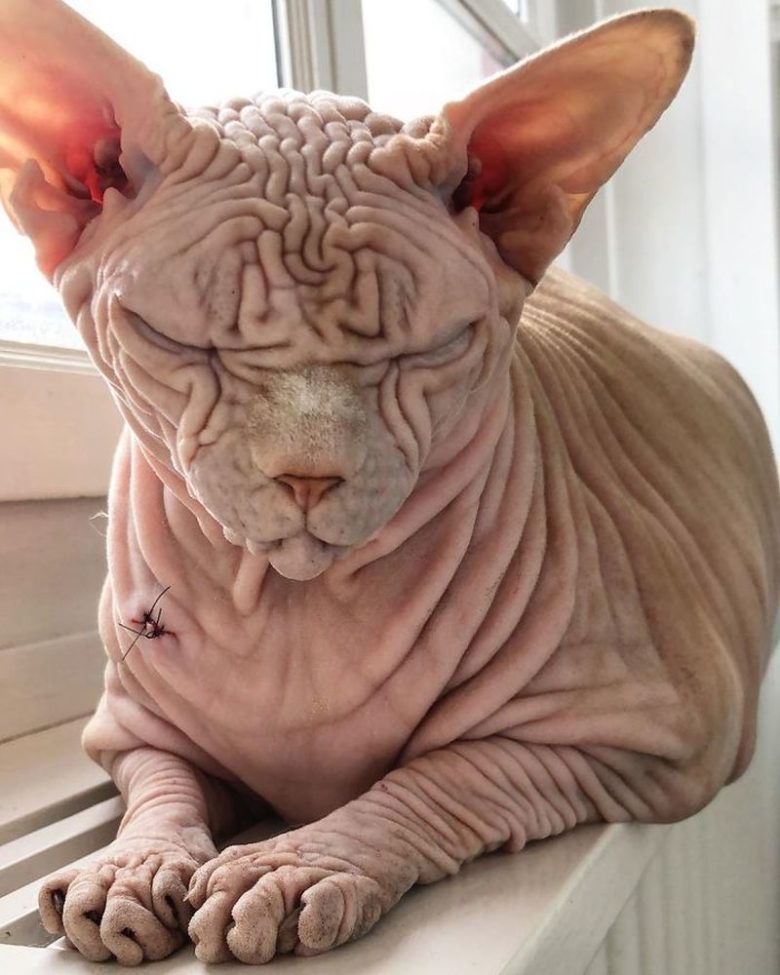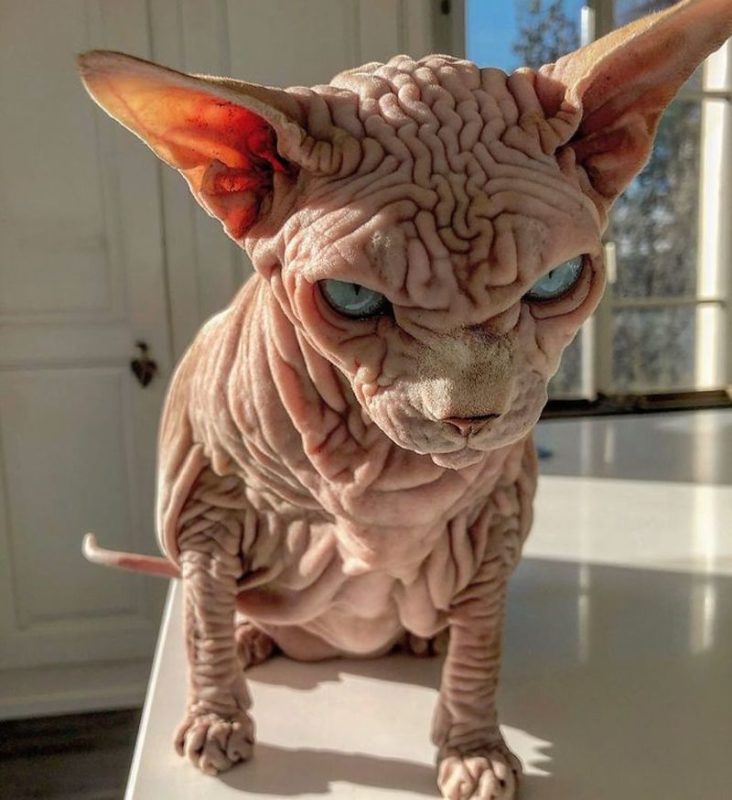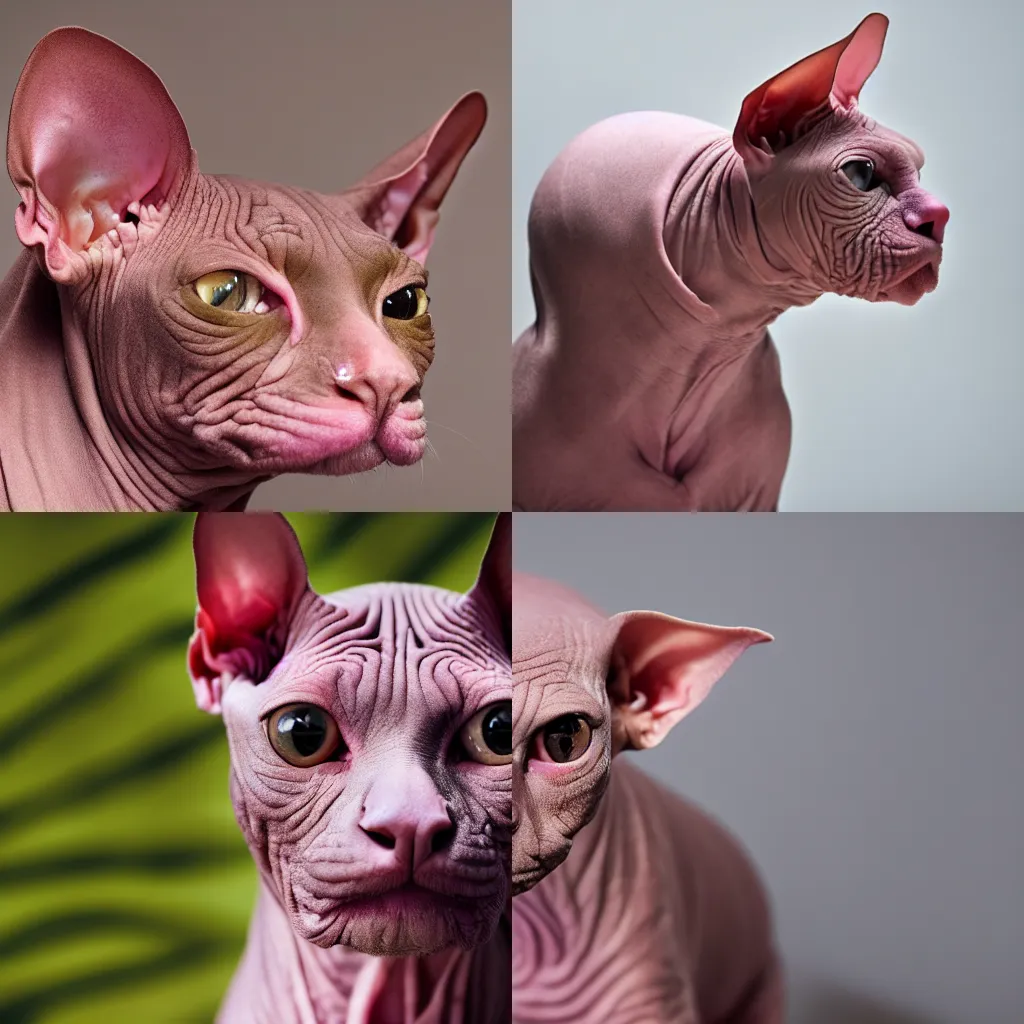Why are hairless cats so wrinkly

The striking appearance of hairless cat breeds, most notably the Sphynx, Donskoy, and Peterbald, is characterized by their distinctive lack of fur and an abundance of skin folds, often referred to as wrinkles. This unique dermatological topography is not merely a superficial trait but a complex manifestation of genetic predispositions, physiological adaptations, and the fundamental structure of feline skin. Understanding the underlying mechanisms that contribute to this wrinkly texture offers comprehensive insight into these fascinating animals.
The primary and most obvious factor contributing to the wrinkly appearance of these felines is the absence of a dense fur coat. In most haired mammals, the fur serves to smooth out the contours of the body, masking the natural folds and elasticity of the skin beneath. Hair follicles, embedded within the skin, also contribute to its overall texture and tension. Without this epidermal covering, the underlying skin, which is naturally elastic and designed to accommodate a wide range of motion, becomes fully exposed. This exposure immediately highlights any excess skin, which, in haired breeds, would simply be filled out by the volume of their coat.
At a deeper physiological level, the skin itself in hairless cats possesses particular characteristics that accentuate its folded nature. Feline skin, like human skin, is composed of several layers, primarily the epidermis (outer layer) and the dermis (inner layer). The dermis is rich in structural proteins, notably collagen and elastin. Collagen provides strength and structure, while elastin confers elasticity and the ability to recoil. The interplay between these proteins determines the skin’s firmness and flexibility. In hairless cats, the relative proportions or organization of collagen and elastin, while generally similar to haired cats, may present differently when not obscured by fur. The skin appears to have a greater degree of laxity or redundancy, allowing it to gather into pronounced folds. This redundancy is not a defect but a feature that permits unrestricted movement and stretching without the constraint of a tight, fur-covered surface.
Genetic mutations are the fundamental cause of hairlessness in these breeds, and these mutations indirectly contribute to the wrinkling. For instance, the Sphynx breed carries a recessive gene mutation in the KRT71 gene (keratin 71), which affects hair follicle development, resulting in the absence or significant reduction of hair. While this gene directly impacts hair production, it does not necessarily reduce the overall surface area of the skin. Consequently, the skin grows to a size that would typically be covered by fur, leading to an “oversized” appearance relative to the body’s volume when devoid of hair. This excess skin then naturally forms folds and creases, particularly around areas of movement such as the neck, chest, and joints. Other hairless breeds, like the Donskoy, have different genetic origins for their hairlessness (a dominant gene that causes progressive hair loss), but the resulting skin redundancy and subsequent wrinkling are similarly observed.
The necessity for skin flexibility and the accommodation of movement also plays a significant role. Cats are highly agile creatures, capable of intricate stretches, jumps, and twists. Their skin must be pliable enough to allow for this extensive range of motion. In the absence of a protective fur layer, the skin itself becomes the primary interface with the environment. A greater surface area of skin, achieved through wrinkling, may offer a slight advantage in terms of flexibility and protection against minor abrasions during movement. The folds allow the skin to stretch and contract without tearing or becoming taut, providing a buffer during physical activity.
Furthermore, the sebaceous glands, which are responsible for producing sebum (the skin’s natural oil), continue to function in hairless cats, often with heightened activity. In haired cats, sebum is distributed along the hair shafts and helps maintain coat health. Without hair, this oil accumulates directly on the skin’s surface and within the folds. This accumulation contributes to the unique tactile sensation of hairless cats’ skin and can also visually emphasize the wrinkles, as the oil can gather in the creases, making them more apparent. This increased sebaceous activity necessitates regular bathing for hairless cats to prevent skin issues and maintain hygiene, further highlighting the unique nature of their exposed skin.
Thermoregulation, or the maintenance of body temperature, is another factor implicitly linked to the skin’s characteristics. Hair acts as an insulator, trapping a layer of air close to the body to prevent heat loss. Hairless cats lack this natural insulation and must compensate in other ways, such as having a slightly higher metabolic rate and often seeking warmer environments. While wrinkles do not directly contribute to insulation, the skin’s structure and its ability to gather and stretch are integral to an animal that relies entirely on its dermal layer for environmental interaction. The skin’s exposed nature and its requirement to be robust yet flexible are paramount.
The development of wrinkles in hairless cats can be considered an example of developmental biology where a genetic mutation in one system (hair growth) has cascading effects that become visible in another (skin morphology). The underlying skin structure is essentially normal, but its appearance is dramatically altered by the absence of its usual covering. This phenomenon is not entirely unique to felines; similar principles can be observed in other wrinkly animal breeds, such as the Shar-Pei dog, where specific genetic mutations lead to an overproduction of hyaluronic acid in the skin, causing extreme skin redundancy and folding. While the specific biochemical pathways differ, the general principle of genetic influence leading to pronounced skin folds remains a common theme in understanding these unique physical traits.
In conclusion, the profoundly wrinkled appearance of hairless cats is a multifaceted characteristic resulting from the fundamental absence of a fur coat, which typically smooths skin contours. This is compounded by the inherent elasticity and redundancy of feline skin, genetically predisposed to grow to a size that would normally accommodate a full coat. The interplay of collagen and elastin, the requirements for extreme skin flexibility to facilitate feline agility, and the ongoing activity of sebaceous glands all contribute to the visible formation and emphasis of these distinctive folds. These wrinkles are not a superficial quirk but a deeply integrated aspect of their unique physiology, demanding specific care and offering a compelling study in dermatological adaptation.
FAQs Women Hairstyles With Names An Exploration Of Style And Identity by why are hairless cats so wrinkly
Q: Are the wrinkles on hairless cats uncomfortable for them?
A: The wrinkles are a natural part of their physiology and generally do not cause discomfort. They allow for the skin’s necessary flexibility during movement. Proper care, including regular cleaning of skin folds, is essential to prevent irritation or infections that could lead to discomfort.
Q: Do all hairless cat breeds have the same degree of wrinkling?
A: The degree of wrinkling can vary among different hairless cat breeds and even among individuals within a breed. Factors such as genetic lineage, age, and individual skin elasticity contribute to the variation in skin folds. Some breeds, like the Sphynx, are particularly known for their pronounced wrinkles.
Q: Is there a benefit to hairless Best Hairstyles For Thin Hair Over Elevating Volume And Style For Mature Finer Strands cats having so many wrinkles? A: The wrinkles primarily provide the necessary skin redundancy for a full range of motion, allowing for the extreme flexibility and agility characteristic of cats. While not a direct “benefit” in the traditional sense, they are an integral part of their unique physical adaptation to hairlessness.
Q: Does the skin of hairless cats require special care due to the wrinkles?
A: Yes, hairless cats require specific dermatological care. The absence of fur means their skin is exposed and more prone to environmental factors. Regular bathing is necessary to remove accumulated oils and debris that can collect in the skin folds, preventing skin issues and maintaining hygiene. Sun protection is also crucial due to their exposed skin.
Q: Are hairless cats born with wrinkles, or do they develop over time?
A: Hairless cats are typically born with their characteristic wrinkles, which are a direct result of their genetic predisposition to hairlessness and skin redundancy. The prominence of these wrinkles may become more apparent as they grow and move, but the underlying structure is present from birth.
Tips by why are hairless cats so wrinkly
1. Regular Skin Fold Cleaning: Implement a routine for cleaning the skin folds. Use a soft, damp cloth or pet-specific wipes to gently clean between the wrinkles, especially in areas prone to oil buildup or moisture, such as the neck, armpits, and groin. This prevents irritation, infections, and unpleasant odors.
2. Appropriate Bathing Schedule: Establish a consistent bathing schedule, typically once a week or every two weeks, using a mild, veterinarian-approved shampoo formulated for sensitive skin. This helps manage the accumulation of sebaceous oils that are not absorbed by fur and can gather in the wrinkles.
3. Moisturize with Caution: After bathing, consider applying a veterinarian-recommended, non-comedogenic moisturizer if the skin appears dry. Avoid products with heavy fragrances or harsh chemicals that could irritate sensitive skin. Always ensure the skin is thoroughly dry after moisturizing to prevent fungal or bacterial growth in the folds.
4. Sun Protection: Hairless skin is susceptible to sunburn. Limit prolonged exposure to direct sunlight, especially during peak hours. Sun-protective clothing designed for pets or veterinarian-approved sunscreen for cats can be utilized when outdoor exposure is unavoidable.
5. Monitor for Skin Issues: Regularly inspect the skin and wrinkles for any signs of redness, irritation, sores, unusual odors, or changes in texture. Early detection of skin problems allows for prompt veterinary intervention, preventing minor issues from escalating.
Conclusion by why are hairless cats so wrinkly
The characteristic wrinkling observed in hairless cat breeds is a fascinating outcome of several interconnected biological factors. It fundamentally stems from the absence of a fur coat, which typically conceals the natural elasticity and redundancy of feline skin. Genetic mutations dictate hairlessness, but the skin itself retains its inherent structure, including collagen and elastin, leading to an “oversized” dermal layer relative to the body’s volume. This physiological adaptation allows for the extensive flexibility and range of motion crucial for feline agility. Furthermore, the active sebaceous glands contribute to the unique skin texture and emphasize the folds through oil accumulation. These wrinkles are not merely an aesthetic feature but a functional aspect of their unique biology, necessitating specific dermatological care to maintain the animal’s health and comfort. Understanding these complex interplays provides valuable insight into the remarkable adaptations of these distinctive felines.







More suggestion: Z Gallerie Dining Table And Chairs An Exploration Of Style Craftsmanship And Functionality